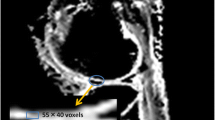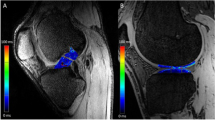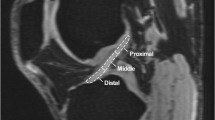Abstract
Objective
To longitudinally monitor remodeling of human autograft following anterior cruciate ligament (ACL) reconstruction with DTI.
Methods
Twenty-eight patients underwent DTI follow-up at 3, 8, and 14 months after clinically successful ACL reconstruction with tendon autograft. Among these, 18 patients had a concomitant lateral extra-articular procedure (LET). DTI data from 7 healthy volunteers was also obtained. Diffusion parameters (fractional anisotropy, FA; mean diffusivity, MD; axial diffusivity, AD; and radial diffusivity, RD) were evaluated within the fiber tractography volumes of the ACL graft and posterior cruciate ligament (PCL) in all patients. Data were analyzed using a linear mixed-effects model with post hoc testing using Bonferroni-Holm correction for multiple testing. The effect of additional LET was studied.
Results
The ACL graft showed a significant decrease of FA over time (F = 4.00, p = 0.025), while the diffusivities did not significantly change over time. For PCL there were no significant DTI changes over time. A different evolution over time between patients with and without LET was noted for all diffusivity values of the ACL graft with reduced AD values in patients with LET at 8 months postoperatively (p = 0.048; adjusted p = 0.387). DTI metrics of the ACL graft differed largely from both native ACL and tendon at 14 months postoperatively.
Conclusion
Our study has shown the potential of DTI to longitudinally monitor the remodeling process in human ACL reconstruction. DTI analysis indicates that graft remodeling is incomplete at 14 months postoperatively.
Key Points
• DTI can be used to longitudinally monitor the remodeling process in human ACL reconstruction.
• DTI analysis indicates that autograft remodeling is incomplete at 14 months postoperatively.
• DTI may be helpful for evaluating new ACL treatments.






Similar content being viewed by others
Abbreviations
- ACL:
-
Anterior cruciate ligament
- AD:
-
Axial diffusivity
- FA:
-
Fractional anisotropy
- LET:
-
Lateral extra-articular tenodesis
- MD:
-
Mean diffusivity
- PCL:
-
Posterior cruciate ligament
- PT:
-
Patellar tendon
- RD:
-
Radial diffusivity
- ST:
-
Semitendinosus tendon
- DTI:
-
Diffusion tensor imaging
References
Harris JD, Abrams GD, Bach BR et al (2014) Return to sport after ACL reconstruction. Orthopedics 37:e103–e108
Hofbauer M, Muller B, Murawski CD, van Eck CF, Fu FH (2014) The concept of individualized anatomic anterior cruciate ligament (ACL) reconstruction. Knee Surg Sports Traumatol Arthrosc 22:979–986
Claes S, Verdonk P, Forsyth R, Bellemans J (2011) The “ligamentization” process in anterior cruciate ligament reconstruction: what happens to the human graft? A systematic review of the literature. Am J Sports Med 39:2476–2483
Janssen RP, Scheffler SU (2014) Intra-articular remodelling of hamstring tendon grafts after anterior cruciate ligament reconstruction. Knee Surg Sports Traumatol Arthrosc 22:2102–2108
Janssen RP, van der Wijk J, Fiedler A, Schmidt T, Sala HA, Scheffler SU (2011) Remodelling of human hamstring autografts after anterior cruciate ligament reconstruction. Knee Surg Sports Traumatol Arthrosc 19:1299–1306
Kaplan Y, Witvrouw E (2019) When is it safe to return to sport after ACL reconstruction? Reviewing the criteria. Sports Health 11:301–305
Falconiero RP, DiStefano VJ, Cook TM (1998) Revascularization and ligamentization of autogenous anterior cruciate ligament grafts in humans. Arthroscopy 14:197–205
Johnson LL (1993) The outcome of a free autogenous semitendinosus tendon graft in human anterior cruciate reconstructive surgery: a histological study. Arthroscopy 9:131–142
Budzik JF, Balbi V, Verclytte S, Pansini V, Le Thuc V, Cotten A (2014) Diffusion tensor imaging in musculoskeletal disorders. Radiographics 34:E56–E72
Van Dyck P, Froeling M, De Smet E et al (2017) Diffusion tensor imaging of the anterior cruciate ligament graft. J Magn Reson Imaging 46:1423–1432
Yang X, Chen D, Li M, Shi D, Zhu B, Jiang Q (2015) Diffusion tensor imaging of the anterior cruciate ligament graft after reconstruction: repeatability and diffusion tensor imaging metrics. J Comput Assist Tomogr 39:244–249
Mukherjee P, Chung SW, Berman JI, Hess CP, Henry RG (2008) Diffusion tensor MR imaging and fiber tractography: technical considerations. AJNR Am J Neuroradiol 29:843–852
Bao Y, Yang L, Chen Y et al (2018) Radial diffusivity as an imaging biomarker for early diagnosis of non-demented amyotrophic lateral sclerosis. Eur Radiol 28:4940–4948
Froeling M, Oudeman J, Strijkers GJ et al (2015) Muscle changes detected with diffusion-tensor imaging after long-distance running. Radiology 274:548–562
Rehmann R, Schlaffke L, Froeling M et al (2019) Muscle diffusion tensor imaging in glycogen storage disease V (McArdle disease). Eur Radiol 29:3224–3232
Van Dyck P, Froeling M, Heusdens CHW, Sijbers J, Ribbens A, Billiet T (2020) Diffusion tensor imaging of the anterior cruciate ligament following primary repair with internal bracing: a longitudinal study. J Orthop Res. https://doi.org/10.1002/jor.24684
Moran CJ, Verdonk PC, Lagae K, DeClercq G (2014) Extra-articular augmentation of anterior cruciate ligament reconstruction: the monoloop procedure. In: Siebold R, Dejour D, Zaffagnini S (eds) Anterior cruciate ligament reconstruction, 1st edn. Springer, Heidelberg, pp 317–326
Veraart J, Fieremans E, Novikov DS (2016) Diffusion MRI noise mapping using random matrix theory. Magn Reson Med 76:1582–1593
Tournier JD, Mori S, Leemans A (2011) Diffusion tensor imaging and beyond. Magn Reson Med 65:1532–1556
Howell SM, Clark JA, Blasier RD (1991) Serial magnetic resonance imaging of hamstring anterior cruciate ligament autografts during the first year of implantation. A preliminary study. Am J Sports Med 19:42–47
Andersson JL, Sotiropoulos SN (2016) An integrated approach to correction for off-resonance effects and subject movement in diffusion MR imaging. Neuroimagee 125:1063–1078
Leemans A, Jones DK (2009) The B-matrix must be rotated when correcting for subject motion in DTI data. Magn Reson Med 61:1336–1349
Chang LC, Jones DK, Pierpaoli C (2005) RESTORE: robust estimation of tensors by outlier rejection. Magn Reson Med 53:1088–1095
Collier Q, Veraart J, Jeurissen B, den Dekker AJ, Sijbers J (2015) Iterative reweighted linear least squares for accurate, fast, and robust estimation of diffusion magnetic resonance parameters. Magn Reson Med 73:2174–2184
Basser PJ, Pajevic S, Pierpaoli C, Duda J, Aldroubi A (2000) In vivo fiber tractography using DT-MRI data. Magn Reson Med 44:625–632
Tournier JD, Calamante F, Connelly A (2012) MRtrix: diffusion tractography in crossing fiber regions. Int J Imaging Syst Technol 22:53–66
Vos SB, Tax CM, Luijten PR, Ourselin S, Leemans A, Froeling M (2017) The importance of correcting for signal drift in diffusion MRI. Magn Reson Med 77:285–299
Holm S (1979) A simple sequentially rejective multiple test procedure. Scand J Stat 6:65–70
Amiel D, Frank C, Harwood F, Fronek J, Akeson W (1984) Tendons and ligaments: a morphological and biochemical comparison. J Orthop Res 1:257–265
Hadjicostas PT, Soucacos PN, Paessler HH, Koleganova N, Berger I (2007) Morphologic and histologic comparison between the patella and hamstring tendons grafts: a descriptive and anatomic study. Arthroscopy 23:751–756
Mommersteeg TJ, Blankevoort L, Kooloos, Hendriks JC, Kauer JM, Huiskes R (1994) Nonuniform distribution of collagen density in human knee ligaments. J Orthop Res 12:238–245
Getgood A, Brown C, Lording T et al (2019) The anterolateral complex of the knee: results from the International ALC Consensus Group Meeting. Knee Surg Sports Traumatol Arthrosc 27:166–176
Williams A, Ball S, Stephen J, White N, Jones M, Amis A (2017) The scientific rationale for lateral tenodesis augmentation of intra-articular ACL reconstruction using a modified Lemaire procedure. Knee Surg Sports Traumatol Arthrosc 25:1339–1344
Robson MD, Gatehouse PD, So PW et al (2004) Contrast enhancement of short T2 tissues using ultrashort TE (UTE) pulse sequences. Clin Radiol 59:720–726
Thein R, Spitzer E, Doyle J et al (2016) The ACL graft has different cross-sectional dimensions compared with the native ACL: implications for graft impingement. Am J Sports Med 44:2097–2105
Veraart J, Sijbers J, Sunaert S, Leemans A, Jeurissen B (2013) Weighted linear least squares estimation of diffusion MRI parameters: strengths, limitations, and pitfalls. Neuroimage 81:335–346
Soares JM, Marques P, Alves V, Sousa N (2013) A hitchhiker’s guide to diffusion tensor imaging. Front Neurosci 7:31
Froeling M, Nederveen AJ, Nicolay K, Strijkers GJ (2013) DTI of human skeletal muscle: the effects of diffusion encoding parameters, signal-to-noise ratio and T2 on tensor indices and fiber tracts. NMR Biomed 26:1339–1352
Sousa PL, Krych AJ, Cates RA, Levy BA, Stuart MJ, Dahm DL (2017) Return to sport: does excellent 6-month strength and function following ACL reconstruction predict midterm outcomes? Knee Surg Sports Traumatol Arthrosc 25:1356–1363
Fleming BC, Vajapeyam S, Connolly SA, Magarian EM, Murray MM (2011) The use of magnetic resonance imaging to predict ACL graft structural properties. J Biomech 44:2843–2846
Chu CR, Williams AA (2019) Quantitative MRI UTE-T2* and T2* show progressive and continued graft maturation over 2 years in human patients after anterior cruciate ligament reconstruction. Orthop J Sports Med 7(8):2325967119863056
Plenge E, Poot DH, Bernsen M et al (2012) Super-resolution methods in MRI: can they improve the trade-off between resolution, signal-to-noise ratio, and acquisition time? Magn Reson Med 68:1983–1993
Van Steenkiste G, Jeurissen B, Veraart J et al (2016) Super-resolution reconstruction of diffusion parameters from diffusion-weighted images with different slice orientations. Magn Reson Med 75:181–195
Acknowledgments
Pieter Van Dyck and Christiaan Heusdens are supported by the research foundation Flanders (FWO Vlaanderen), Belgium (grants 1831217N and T001017N, respectively).
Funding
The authors state that this work has not received any funding.
Author information
Authors and Affiliations
Corresponding author
Ethics declarations
Guarantor
The scientific guarantor of this publication is Pieter Van Dyck.
Conflict of interest
Thibo Billiet is an employee of Icometrix, Leuven, Belgium. Other authors of this manuscript declare no relationships with any companies, whose products or services may be related to the subject matter of the article.
Statistics and biometry
Ella Roelant, biostatistician at the Antwerp University Hospital, provided statistical analyses for this manuscript.
Informed consent
Written informed consent was obtained from all subjects in this study.
Ethical approval
Institutional Review Board approval was obtained.
Study subjects or cohorts overlap
The 7 healthy controls were also included in a previous study that analyzed DTI changes of the ACL following primary repair. This paper is published in the Journal of Orthopaedic Research (https://doi.org/10.1002/jor.24684).
Methodology
• prospective
• cross-sectional study
• performed at one institution
Additional information
Publisher’s note
Springer Nature remains neutral with regard to jurisdictional claims in published maps and institutional affiliations.
Electronic supplementary material
ESM 1
(XLSX 23 kb)
Rights and permissions
About this article
Cite this article
Van Dyck, P., Billiet, T., Desbuquoit, D. et al. Diffusion tensor imaging of the anterior cruciate ligament graft following reconstruction: a longitudinal study. Eur Radiol 30, 6673–6684 (2020). https://doi.org/10.1007/s00330-020-07051-w
Received:
Revised:
Accepted:
Published:
Issue Date:
DOI: https://doi.org/10.1007/s00330-020-07051-w




